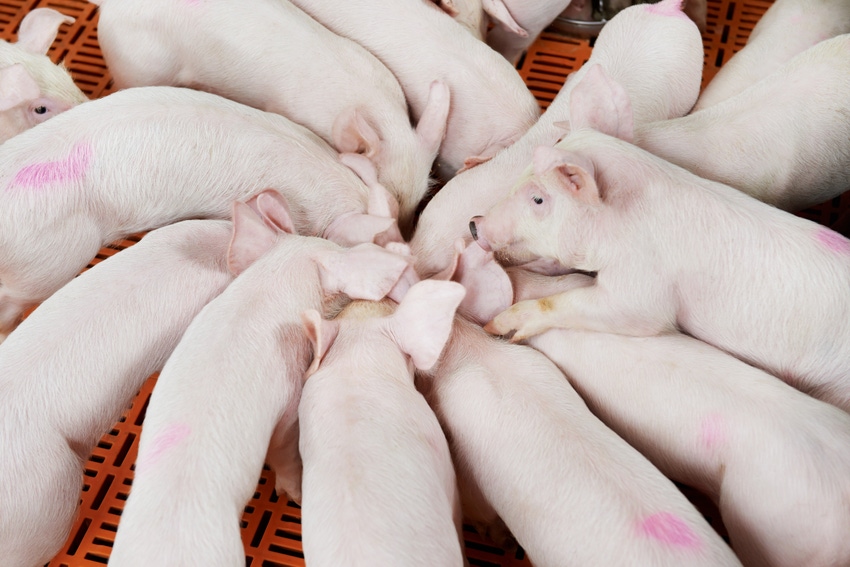Pre-weaning management and nutrition strategies can be used to improve feed intake in immediate post-weaning period.
March 11, 2021

Weaning is a crucial phase of swine production marked by a multitude of biological and environmental stressors, which have a significant impact on immediate post-weaning behavior and feed intake. Low feed consumption immediately after weaning disrupts nutrient intake and results in what is commonly known as a post-weaning growth check. While most pigs recover from this initial reduction in body weight gain, some pigs fail to successfully make the weaning transition leading to morbidity and mortality. This article will discuss a project in which we summarized different pre-weaning management and nutrition strategies that can be used to improve feed intake in the immediate post-weaning period.

Maternal nutrition: Nutritional strategies to influence uterine conditions have been suggested throughout the literature. While it is understood that vitamin and mineral nutrition, glucose transport, and growth hormone circulation play crucial roles in fetal growth and development, there are still several gaps in knowledge when it comes gestation and lactation feeding programs specifically designed to influence piglet growth and reduce piglet stress after weaning. Strategies that appear promising include L-glutamine or fatty acid supplementation, the successful use of BCAA, and the implementation of perinatal flavor learning. However, few have gained industry-wide application as a result of limited research. Regardless of diet formulation, the amino acid and energy intake of sows remains of utmost importance for milk production and subsequent litter gain in order to better prepare pigs for weaning.
Management: Research consistently demonstrates that weaning older, more developmentally mature pigs helps prevent many of the adverse gastrointestinal effects associated with weaning stress. In contrast, research on the effects of cross-fostering and split-suckling on the feed intake of pigs after weaning is limited; however, it is understood that providing greater opportunities for piglets to nurse prior to weaning should improve nutrient intake and weaning body weight, creating a more robust pig for the post-weaning period. Another management strategy that has recently sparked interest is piglet socialization. Allowing pigs to interact with one another before weaning improves social skills, minimizing mixing stress and aggression related injury post-weaning. Despite these added benefits, early mixing strategies have not been widely adopted in practical operations due to the logistics and cost of retrofitting farrowing houses to accommodate litter socialization. The risk of disease transmission when mixing litters has also prevented application. As interest in this area increases, more research is needed to fully understand the effects of early mixing on post-weaning feed intake and growth performance.
Piglet nutrition: Providing creep feed to pigs during lactation is a reliable strategy that has been shown to increase immediate post-weaning feed intake by acclimating pigs to solid feed prior to weaning. Adding a “play” element to creep feeders has further improved post-weaning feed intake and growth by encouraging exploratory behavior. This implies that adding toys or other attractants at the creep feeder may be considered an easy applicable feeding enrichment strategy that can be used reduce weaning stress and improve the health, welfare and productivity of piglets around weaning. Creep feeding large diameter pellets (ex. 12 mm) is another strategy that has been shown to increase feed intake and body weight gain after weaning. Providing milk replacer to litters pre-weaning has also been shown to elicit a positive response in pre-weaning growth performance, which may help to reduce pre-weaning mortality. While milk replacer is acknowledged to ease the weaning transition by creating a heavier pig for weaning, its use has not been widely adopted due to labor and application challenges. Lastly, topsoil exposure pre-weaning, as in the work from University of Arkansas, is a promising area that requires more research to better understand the influence of gut microbial population on immune status and subsequent productivity.
In summary, strategic nutrition and management practices must focus on maintaining continuity of nutrient intake in order to reduce morbidity and mortality in the immediate post-weaning period. While more research is needed to develop strategic pre-weaning programs, many of the strategies presented in this article provide opportunities for producers to encourage interaction with the feeder, prevent feed neophobia, and reduce stress around the time of weaning. For more information, we would direct you to a video and paper on the subject.
Sources: Madie Wensley, Mike Tokach, Jason Woodworth, Robert Goodband, Jordan Gebhardt, Joel DeRouchey, and Denny McKilligan, Kansas State University, TechMix Inc., who are solely responsible for the information provided, and wholly own the information. Informa Business Media and all its subsidiaries are not responsible for any of the content contained in this information asset.
You May Also Like



